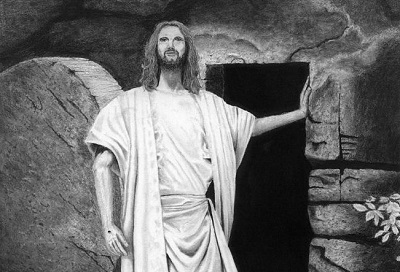The significance of the resurrection

He is not here; He has risen, just as He said. Come and see the place where He lay – Matthew 28:6 NIV
INTRODUCTION.
The resurrection of Christ is the supreme miracle. Accept it, and you can accept all the others. It is unique, unlike all other miracles-even the raising of Jairus’s daughter, the widow’s son, and Lazarus. The evidence for the resurrection miracle here is twofold: the empty tomb and His presence with His doubting friends. The body of Jesus, though recognisable by faith, was not bound by time and space.
The two travellers to Emmaus could not recognise Him immediately.
He then “disappeared from their sight.” From Emmaus they returned to the Eleven in Jerusalem, and Jesus appeared suddenly in their midst. The challenge of Jesus to the troubled friends was threefold: (1) touch me, (2) feed me, (3) hear me.
The power of the resurrection continues to strengthen and bless His believing friends. Only Luke, and in Acts 1:19 cites the ascension, perhaps to assure us that His body is a spiritual body. The appearances evoked worship, joy, and praise. The resurrection miracle fulfilled Scripture and Jesus’s own predictions. It is the strongest evidence Jesus is the Messiah promised Israel and the Saviour given to the world.
Here are Four ways the New Testament highlights the significance of the resurrection.
- JESUS’ RESURRECTION MEANS THAT HIS SACRIFICIAL DEATH ON THE CROSS WAS SUFFICIENT, THEREFORE, OUR SINS CAN BE FORGIVEN.
Paul emphasises this in 1 Corinthians 15, reminding us that “Christ died for our sins in accordance with the Scriptures, that He was buried, that He was raised on the third day in accordance with the Scriptures” (vv. 3-4). Then, in verse 17, he argues that “if Christ has not been raised, your faith is futile and you are still in your sins.”
In other words, Paul saw a direct connection between the resurrection of Jesus and the sufficiency of His death to atone for our sins. When Jesus rose again on the third day, it was the public announcement that God was fully satisfied with the sacrificial death of His Son. In His resurrection, Jesus was vindicated, as we read in 1 Timothy 3:16. But in His vindication, we are vindicated too. That’s why Paul says in Romans 4 that Jesus “was delivered up for our trespasses and raised for our justification”- Romans 4:25.
- JESUS’ RESURRECTION MEANS THAT DEATH IS DEFEATED ONCE AND FOR ALL.
As Peter proclaimed on the Day of Pentecost, “God raised Jesus from the dead, freeing Him from the agony of death, because it was impossible for death to keep its hold on Him” – Acts 2:24. Death lost its grip on Jesus!
But the resurrection means that Jesus not only defeated death for Himself, but that He defeated it for us. He died and rose as a new representative for humanity, as the Second Adam. “But in fact Christ has been raised from the dead,” Paul writes, “the first fruits of those who have fallen asleep. For as by a man came death, by a man has come also the resurrection of the dead. For as in Adam all die, so also in Christ shall all be made alive” – 1 Corinthians 15:20-22). His resurrection guarantees ours.
Perhaps no one has said this more eloquently than C. S. Lewis. In his 1947 book “Miracles”, Lewis wrote: “The New Testament writers speak as if Christ’s achievement in rising from the dead was the first event of its kind in the whole history of the universe. He is the ‘first fruits,’ the ‘pioneer of life.’ He has forced open a door that has been locked since the death of the first man. He has met, fought, and beaten the King of Death. Everything is different because He has done so. This is the beginning of the New Creation: a new chapter in cosmic history has been opened.” The empty tomb assures us that sickness and suffering, death and disease will not have the final word.
- JESUS’ RESURRECTION MEANS THAT THE MATERIAL WORLD MATTERS.
Lest there be any misunderstanding, when the apostles said that Jesus rose again, they meant that His physical body came back to life. The risen Jesus wasn’t a phantom or ghost, but a breakfast-eating, flesh-and-bone, human as we read in Luke 24:36-43 and John 21:1 14. As the Pulitzer-Prize winning novelist, John Updike once said,
Make no mistake: if He rose at all it was as His body; if the cells’ dissolution did not reverse, the molecules reknit, the amino acids rekindle, the Church will fall. When Jesus’ came out of the tomb in a physical body, it was God’s definitive stamp of approval on the creation project with all of its materiality. The resurrection shows us that matter matters. And this is why the early Christians looked to the future with confidence that the created order itself would be redeemed as we read in Romans 8:18-25.
Though we wait for the full consummation of new creation, the Scriptures also teach that the power that raised Jesus from the dead is already working within us as we read in Ephesians 1:19-20. The resurrection, you see, not only assures of God’s forgiveness and comforts us in suffering as we anticipate the final reversal of death, disease, and decay; it motivates and empowers us to push back the tide of suffering and evil in the present world, through word and deed, in mercy and in justice, all in Jesus’ name.
Jesus embodied and demonstrated the oxymoron of the crucified life, that a self-centred life is misery, and that genuinely abundant living occurs only when one dies to self-interest as we read in Matthew 10:38-39; 16:24-28; 20:26-28; 23:12. Paul developed this further, teaching us that Jesus’ followers died with Him to the old life and arose with Him to life anew as we read in Romans 6:1-11. But this transformative model of the cross leading to the crown is a farce if Jesus’ suffering did not lead to His resurrection and heavenly reign. Paul’s basis for teaching the Philippians to live in humility and unity is simply to tell the story of Jesus, centring on how His past humility led to His future exaltation as we read in Philippians 2:1-13.
End Piece
The Gospel of Luke also records Jesus’s resurrection and the women’s obedience in relaying the angel’s message to the rest of the disciples. Luke also gives us details into Jesus’s post – resurrection appearances, which proved His resurrection and provided Him the opportunity to give final charges to His disciples before ascending to heaven. Jesus appeared to two disciples on the road to Emmaus, when He also confirmed that all of Scripture points to Himself. Jesus later appeared to the Apostles and showed them His hands and feet. He prompted them to believe the resurrection by eating with them and interpreting the Old Testament in light of His sufferings and resurrection. Jesus identified Himself as the Messiah. His time on earth ended with a commission to His disciples. He left them with the charge to minister and proclaim the gospel on Jesus’s behalf. As Jesus’s disciples today, we know Him because others have been faithful to carry His gospel around the world, and we pick up where those disciples left off as Jesus’s faithful ambassadors.
- INVITATION
If you have not yet confessed Jesus as your Lord and personal Saviour, this is an opportunity to do so. And when you do, just surrender totally to Him with your eternal future, for He will never leave nor forsake you – Hebrews 13:5
STAY BLESSED!
For further inquiries please contact us on Tel Nos. 0243588467 or 0268130615
Email: saltnlightministries@gmail.com
Website: saltandlightministries.org
By Dr Joyce Aryee, the author













